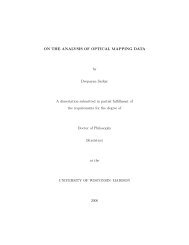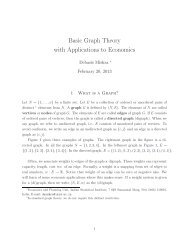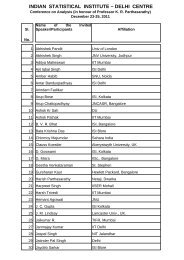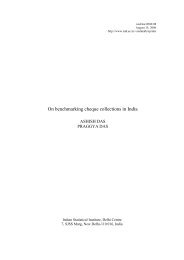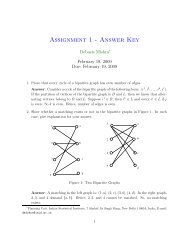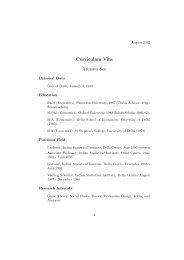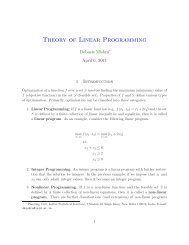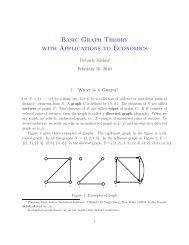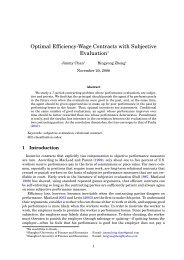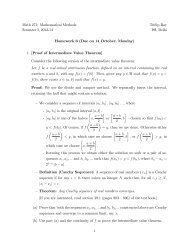Normal approximation to the hypergeometric distribution in ...
Normal approximation to the hypergeometric distribution in ...
Normal approximation to the hypergeometric distribution in ...
You also want an ePaper? Increase the reach of your titles
YUMPU automatically turns print PDFs into web optimized ePapers that Google loves.
S.N. Lahiri et al. / Journal of Statistical Plann<strong>in</strong>g and Inference 137 (2007) 3570 –3590 3577<br />
Table 4<br />
Values of <strong>the</strong> maximal error of <strong>Normal</strong> <strong>approximation</strong> <strong>to</strong> Hypergeometric <strong>distribution</strong> (viz., (N,p,f)of (3.1)) at N = 500 and <strong>the</strong> correspond<strong>in</strong>g<br />
values of <strong>the</strong> maximal error for <strong>the</strong> B<strong>in</strong>omial (n, p) <strong>distribution</strong> where n = Nf and p, f ∈{0.5, 0.6, 0.7, 0.8, 0.9}<br />
Hypergeometric B<strong>in</strong>omial<br />
n = 250 300 350 400 450 n = 250 300 350 400 450<br />
p = 0.5 0.0356 0.0364 0.0389 0.0445 0.0592 0.0252 0.0230 0.0213 0.0199 0.0188<br />
p = 0.6 0.0364 0.0376 0.0407 0.0472 0.0635 0.0274 0.0250 0.0232 0.0217 0.0205<br />
p = 0.7 0.0389 0.0407 0.0446 0.0523 0.0712 0.0311 0.0284 0.0263 0.0246 0.0232<br />
p = 0.8 0.0801 0.0872 0.0990 0.1200 0.1683 0.0378 0.0345 0.0319 0.0299 0.0282<br />
p = 0.9 0.1124 0.1224 0.1390 0.1683 0.2355 0.0530 0.0484 0.0449 0.0420 0.0396<br />
Table 5<br />
Values of <strong>the</strong> maximal error of <strong>Normal</strong> <strong>approximation</strong> <strong>to</strong> Hypergeometric <strong>distribution</strong> (viz., (N,p,f)of (3.1)) at N = 2000 and <strong>the</strong> correspond<strong>in</strong>g<br />
values of <strong>the</strong> maximal error for <strong>the</strong> B<strong>in</strong>omial (n, p) <strong>distribution</strong> where n = Nf and p, f ∈{0.5, 0.6, 0.7, 0.8, 0.9}<br />
Hypergeometric B<strong>in</strong>omial<br />
n = 1000 1200 1400 1600 1800 n = 1000 1200 1400 1600 1800<br />
p = 0.5 0.0178 0.0182 0.0195 0.0223 0.0297 0.0126 0.0115 0.0107 0.0010 0.0094<br />
p = 0.6 0.0182 0.0188 0.0204 0.0237 0.0319 0.0137 0.0125 0.0116 0.0109 0.0102<br />
p = 0.7 0.0195 0.0204 0.0224 0.0263 0.0358 0.0156 0.0142 0.0132 0.0123 0.0116<br />
p = 0.8 0.0401 0.0437 0.0496 0.0602 0.0846 0.0189 0.0173 0.0160 0.0150 0.0141<br />
p = 0.9 0.0564 0.0614 0.0698 0.0846 0.1189 0.0266 0.0243 0.0225 0.0210 0.0198<br />
From Tables 2–5, it also follows that for a given value of N, if <strong>the</strong> parameter p is held fixed at a given level, <strong>the</strong><br />
maximal error of <strong>approximation</strong> <strong>to</strong> <strong>the</strong> Hypergeometric <strong>distribution</strong> <strong>in</strong>creases mono<strong>to</strong>nically as <strong>the</strong> value of f (i.e.,<br />
n) <strong>in</strong>creases, and vice versa. However, <strong>the</strong> sample size n and <strong>the</strong> value of p alone do not give a true <strong>in</strong>dication of<br />
<strong>the</strong> accuracy of <strong>the</strong> <strong>Normal</strong> <strong>approximation</strong> <strong>to</strong> <strong>the</strong> Hypergeometric <strong>distribution</strong>. To get a better estimate of <strong>the</strong> level of<br />
accuracy, one must consider <strong>the</strong> comb<strong>in</strong>ed effect of all three parameters N, f and p. Theorem 1 implies that <strong>the</strong> comb<strong>in</strong>ed<br />
effect of all three parameters on <strong>the</strong> maximal error of <strong>approximation</strong> can be expressed <strong>in</strong> terms of 1/(N,p,f), where<br />
[(N,p,f)] 2 = Nfp(1 − p)(1 − f). To that effect, we def<strong>in</strong>e <strong>the</strong> co-efficient c(N, p, f ) ∈ (0, ∞) by <strong>the</strong> relation<br />
Thus,<br />
c(N, p, f ) = (N,p,f)(N,p,f). (3.2)<br />
(N,p,f)≡ c(N, p, f )[(N,p,f)] −1 .<br />
Us<strong>in</strong>g Theorem 1 and <strong>the</strong> lattice property of (X − E(X))/ √ Var(X), it can be shown that <strong>the</strong>re exist two constants<br />
C5,C6 ∈ (0, ∞) such that:<br />
C5 c(N, p, f )C6<br />
for all N,p,f, whenever (N,p,f)>0. If we knew <strong>the</strong> approximate value of C6 or of <strong>the</strong> co-efficient c(N, p, f ),<br />
we could use C6[(N,p,f)] −1 or c(N, p, f )[(N,p,f)] −1 as a guidel<strong>in</strong>e for assess<strong>in</strong>g <strong>the</strong> accuracy of <strong>Normal</strong><br />
<strong>approximation</strong> for <strong>the</strong> Hypergeometric <strong>distribution</strong>. Tables 6–9 below give <strong>the</strong> values of <strong>the</strong> co-efficient c(N, p, f ) for<br />
different values of N,p,f.<br />
Tables 6–9 show that <strong>the</strong> co-efficients c(N, p, f ) are surpris<strong>in</strong>gly stable as a function of N, i.e., it exhibits very m<strong>in</strong>or<br />
variation as a function of N for a given value of <strong>the</strong> pair (p, f ). In a specific application with a given set of values of p<br />
and f, one can use c(N, p, f )[(N,p,f)] −1 from Tables 6–9 <strong>to</strong> decide on <strong>the</strong> suitability of normal <strong>approximation</strong> <strong>to</strong><br />
<strong>the</strong> Hypergeometric probabilities.



